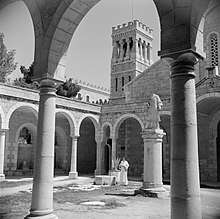École Biblique
École biblique et archéologique française de Jérusalem, commonly known as École Biblique, is a French academic establishment in Jerusalem specializing in archaeology and Biblical exegesis.

History
The school was founded in 1890 under the name École pratique d’études bibliques by Marie-Joseph Lagrange, a Dominican priest. In 1920, it took its current name, following its recognition, by the Académie des Inscriptions et Belles-Lettres, as a national archaeological school in France.
The school is part of the Dominican St. Stephen's Priory, French: "Couvent de Saint-Étienne". Most of the teachers of the École Biblique are Dominican friars, and all members of the Dominican priory are involved in the work of the École.[1]
The priory is centred around the modern Basilica of St Stephen (Saint-Étienne) built over the ruins of an ancient predecessor, to which the supposed relics of Saint Stephen were transferred in 439, making the Byzantine-period church the centre of the cult of this particular saint.
Since its creation, the school has been involved in the exegesis of biblical text, and has carried out archaeological research, in a complementary manner and without secrecy, in Palestine and the adjacent territories. Its principal disciplines are epigraphy, the Semitic languages, Assyriology, Egyptology, other aspects of ancient history, geography, and ethnography.
It has the power to confer official doctorates in Holy Scripture. It publishes the Revue Biblique, which is a diverse collection of scholarship from its fields of excellence, and it also publishes material addressed to larger audiences, including a particular French translation of the Bible, known as the Jerusalem Bible (a work which strove both for critical translational rigour and for quality as a piece of literature).
Following the discovery of the Dead Sea Scrolls, the scholars at the school have been heavily involved in the translation and interpretation of the texts.
The school and its founder were, for a long time, regarded as 'suspect' by the Vatican authorities, as a consequence of the Modernist Crisis. Lagrange himself, like other scholars involved in the 19th century renaissance of biblical studies, was suspected of being a Modernist.[2] The school was briefly closed.
In 1909, conflict between the Dominicans and the Jesuits, common at the time, resulted in the Pope's creation of the Pontifical Biblical Institute, as a Jesuit rival to the school.[3] The dispute between the Jesuits and the Dominicans (and their respective institutions) has gradually calmed down, particularly after the 1943 papal encyclical Divino afflante Spiritu.
Notable members
Among its most illustrious members, in addition to Marie-Joseph Lagrange, are Marie-Emile Boismard, Roland de Vaux, Raymond-Jacques Tournay, Jerome Murphy-O'Connor, and Pierre Benoit.
- Félix-Marie Abel (1878–1953)
- pl:Charles Coüasnon, led the 1961–1977 excavations at the Church of the Holy Sepulchre
- Jean-Baptiste Humbert (born 1940)
- Louis-Hugues Vincent (1872–1960)
References
- Aviva Bar-Am, St. Stephen’s Monastary [sic] – The brothers' work, Jerusalem Post, 14 September 2009
- Bernard Montagnes, Marie-Joseph Lagrange, éd. Cerf, 2004, pp. 204–205 extraits en ligne
- Bernard Montagnes, Les séquelles de la crise moderniste. L'Ecole biblique au lendemain de la Grande Guerre, in Revue thomiste, XCVIIIth year vol. XC, n°2, pp. 245–270, 1990